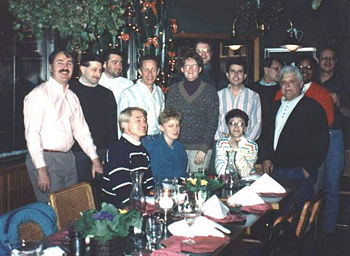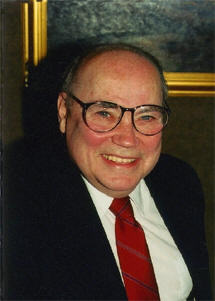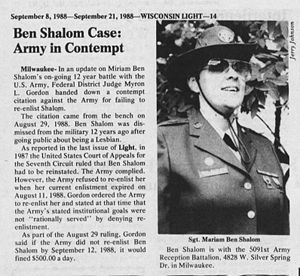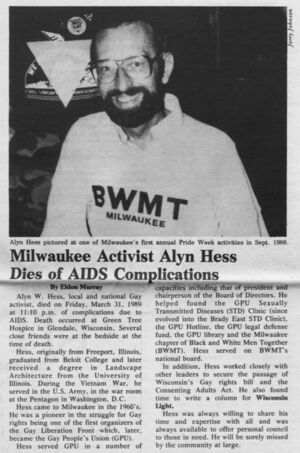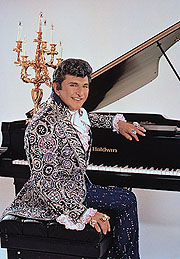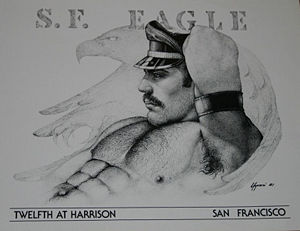Wis. LGBT History-- People
PEOPLE in Wisconsin's LGBT History
The "People" section of the Wisconsin LGBT History Project website contains the biographies of over 200 individuals who helped lay the groundwork for the rights that gays and lesbians enjoy today, but who also dreamed of even more. These people, and people like them, continue to have a vision to advance our rights to make us truly equal citizens. Information is being collected on over 200 additional people, with pages yet to be built for them.
The People section also contains information on the Drag scene and Pageants, with listings of over 100 title holders, and several hundered performing "drag queens" over the years; AND the Leather scene and leather titles.
A few examples (see the Web Site for more details and all 200 bios):
Eldon Murray
(1930-2007)
LGBT Wisconsin can boast of many contributions to our national Gay community. They include the first ever statewide Gay civil rights law and the first ever openly Lesbian Congresswoman, Tammy Baldwin. We have also made a number of contributions that aren't as well known. Eldon Murray is one of those. A true pioneer in the Gay civil rights movement. In 1998, the International Gay and Lesbian archives named him one of the "pioneers of the movement"; he is one of only 32 people to receive that honor.
Eldon Eugene Murray was a longtime resident of Milwaukee's East Side. Beginning in the late 1960s, when being gay was still a taboo to many, Eldon was proud of who he was, setting an example and freeing many other gay men and women to follow as they themselves "came out". Locally he founded numerous gay/lesbian organizations, many of which were "firsts" nationally. He has often been named and recognized throughout the country as one of just 5 or 6 people nationally who truly made the gay rights movement of the 1960s-1970s come about.
At first, Eldon's life moved along like most others. Then came the watershed event in Gay history: Stonewall. Eldon got involved in what was then called "Gay Liberation" in a big way. "I was 39 years old and established in business," he says. "My clients didn't care as long as I made money for them. I could stand up and be openly Gay when few people could."
That ability launched a remarkable string of projects that established a legacy still felt today. Along with his friend Alyn Hess and a handful of others, Eldon launched Wisconsin's oldest LGBT group, Gay People's Union. Most of Milwaukee's LGBT organizations are in one way or another descended from GPU.
His influence reached outside of Milwaukee too. Eldon became editor of one of America's first LGBT publications, GPU News. "I was nominated for it during a meeting," he says. "I agreed because I saw a need." He answered that need for the next ten years. The monthly GPU News was a glossy covered magazine containing news, commentaries, fiction and poetry. It had a national circulation and a national reputation. A lack of volunteers led to its demise in 1981.
Eldon didn't confine his activities to GPU News. He began what could have been the first LGBT radio program in the country. The program Gay Perspectives was a weekly prime time show, with news, music and an occasional interview.
He was also instrumental in founding the first Gay STD clinic in the country. The GPU STD Clinic later became the BESTD Clinic.
Having been a founder of the community and a recognized national leader would have been enough for most of us, but not Eldon. Murray. In 1993, the Cream City Foundation gave him a grant to attend a SAGE (Senior Action in a Gay Environment) conference in New York. It was money well spent. Eldon came back to Milwaukee and founded a chapter of SAGE here. The group currently has around 100 active members.
Miriam ben Shalom
(living)
Miriam Ben Shalom was a Staff Sergeant in the U.S. Army who was discharged when the revealed she was a lesbian. This began a lifetime of fighting the Army's discharge and for the rights of gays in the military. Miriam was also active in the lesbian and feminist movements.
In 1974, Miriam began serving with the 84th Training Division of the Army Reserves. She also completed drill instructor's school, and became one of the two first female drill sergeants in the division. In 1976, she was officially discharged from the Army Reserves for declaring and admitting she was a lesbian. However, she decided to challenge the policy and sue for re-instatement. In May 1980, Judge Terence Evans of the U.S. District Court in Chicago ruled that Ben-Shalom's discharge violated the First, Fifth, and Ninth amendments of the Constitution. He added that sexual orientation should be protected from governmental regulation, including that of the military. The right to freedom of speech was central to Ben-Shalom's case. The Army Reserves did not discharge her because of homosexual conduct, but rather for her statement that she was a lesbian. Through his ruling, Judge Evans made clear that the First Amendment applied to gay and lesbian service members. The U.S. Army appealed this decision, but withdrew its appeal shortly thereafter. And even though Judge Evans had ordered Ben-Shalom's reinstatement, the army simply refused to comply with the order.
Ben-Shalom continued to fight the Army, and in 1987, the U.S. Court of Appeals in Chicago supported the lower court's previous ruling. Still the Army balked. Only when the court threatened the Army with serious contempt of court fines did it relent. In September 1988, Ben-Shalom successfully re-enlisted and became the first openly gay or lesbian service member to be reinstated. However, the Army appealed the decision. In August 1989, a federal appeals court ruled against Ben-Shalom. Judge Harlington Wood, Jr., did not see the case as solely about freedom of speech. He concluded that since the military banned homosexuals, her admission--regardless of her sexual conduct-justified her discharge. In response, Ben-Shalom appealed the case to the United States Supreme Court. On February 26, 1990, the Supreme Court refused to hear her case, thereby upholding the previous ruling of her discharge.
Although the Supreme Court's refusal to hear her case ended Ben-Shalom's military career, her LGBT activism continued. She founded the Gay, Lesbian and Bisexual Veterans of America, Inc. (GLBVA) in 1990 serving as its first president. That organization is now known as the American Veterans For Equal Rights, Inc. (AVER). She also served as one of the Vice Presidents of the organization that has come to be known as PrideFest, and she continues to be a voice for LGBT equality and social justice.
Miriam Ben-Shalom was the first gay or lesbian service member to be reinstated to her position in the United States military after being discharged for her sexual orientation. Even though the army eventually forced her out, she was able to serve successfully in the U.S. Army Reserves as an open lesbian, undermining the U.S. military's argument that open gays and lesbians pose a threat to military effectiveness. Miriam Ben-Shalom is a lifelong resident of Wisconsin having been born in Waukesha, WI in 1948, and continues to reside in Milwaukee.
Alyn Hess
(1939-1989)
Alyn Hess was one of Milwaukee's earliest gay rights activists. He helped to bring about Milwaukee's Gay Rights Ordinance, which prohibits discrimination in employment, housing and public accomodations on the basis of sexual orientation, and worked to secure similar legislation at the state level.
Much of Alyn's work evolved around his involvement in Gay People's Union, which he helped to found and which he served over the years in various positions including president and chairperson of the board of directors. He helped to establish the GPU STD (Sexually Transmitted Diseases) Clinic, later known as the Brady East STD Clinic, and he established the GPU Hotline, both of which still operated for years after his death. He was active in organizing the Milwaukee AIDS Project; and well before the state's Gay Rights VBill was passed, worked closely with Wisconsin Civil Liberties Union as GPU and WCLU together took a job discrimination case all the way to the Wisconsin Supreme Court. He worked closely with Miriam Ben Shalom's discrimination case against the U.S. Army. We was one of the first men to join the Wisconsin Chapter of National Organization for Women (NOW), and was one of the founders of the local BWMT (Black and White Men Together) chapter, serving on that organization's national board.
Mr. Hess was active in politics and worked with many carefully selected candidates for office over the years, most recently prior to his death the Jesse Jackson for President campaign. Hess was one of the first persons in the Wisconsin gay liberation movement to come out of the closet, and he did many speaking engagements for the cause, appearing on radio and television when such actions were considered radical and daringly brave. His radio work included a weekly radio show started in 1971, called "Gay Perspectives", which was one of the earliest and longest running regularly scheduled gay-themed shows in the nation.
Alyn passed away on March 31, 1989 due to AIDS-related complications. Funeral services were attended by the County Executive, several aldermen, the chief of police, and many other notables. Newly elected Mayor John Norquist issued a proclamation (only his 3rd since taking office).
Liberace
(1919-1987)
Liberace was born Wladziu Valentino Liberace at 1649 60th Street, in West Allis, Wisconsin, on May 16, 1919, the survivor of twins.
Over the years Liberace acquired an astounding array of prestigious awards, including: Instrumentalist of the Year, Best Dressed Entertainer and Entertainer of the Year. He also earned two Emmy Awards, six gold albums, two stars on the Hollywood Walk of Fame. He is listed in the Guinness Book of World Records as the world's highest paid musician and pianist. Best of all, he was known and loved throughout the world as "Mr. Showmanship."
There was music in the family; Liberace's father and some siblings were also in the music industry. It is widely believed that some of Liberace's first performances were in Milwaukee's gay establishments, although this is undocumented to date. But he was an extremely talented pianist with a special flair, and quickly became in demand both locally and then nationally. By 1940 he was appearing in New York's Plaza Hotel as an intermission pianist, and he soon became a national icon; for decades, Liberace was known for his music, candelabra, charisma, diamonds and dazzle. Liberace transported audiences to a dazzling world of color, joyful music, glittering costumes, and humor. Liberace had fun with his costumes, cars and homes.
A national television series debuted in 1952. Liberace turned to daytime television in 1960, with a series on ABC. For three years, 1976 - 1979, Liberace was acclaimed "Pop Keyboard Artist of the Year" by Contemporary Keyboard Magazine. Liberace returned to television in 1978 with his first American TV special for CBS, followed by a second in February 1979.
In 1977 Liberace founded the non-profit Liberace Foundation for the Performing and Creative Arts. Liberace considered the Foundation, which funds scholarships for schools and colleges across the nation, as one of his greatest achievements. On April 15, 1979, Liberace opened The Liberace Museum in Las Vegas, Nevada.
In 1980, Las Vegas named him both Star of the Year and Entertainment Personality of the Year. In 1981, Pacific Pioneer Broadcasters presented him with its coveted "Golden Mike" award. In 1982, he was voted to the Keyboard Magazine Hall of Fame by the publications' readers. Also in 1982, Liberace made a special showcase appearance at the Academy Awards, performing all five nominated film themes.
In the spring of 1984 Liberace's premier engagement at New York's famed Radio City Music Hall broke all sales and attendance records of the 51-year history of the Art Deco palace. More than 80,000 people were on hand for what Liberace described as "the fulfillment of a dream and the culmination of my 40 years in show business." Commenting on the engagement, The Wall Street Journal said: "Liberace occupies his own special rhinestone-studded niche in the American dream."
Liberace's final performances were at Radio City Music Hall October 16 through November 2, 1986. After his Radio City engagement he went on a four-city-tour to promote his fourth book, "The Wonderful Private World of Liberace." Then he returned to his Palm Springs home where he passed away on February 4, 1987, just a few months before his 68th birthday. Liberace's death was later reported to have been of complications from AIDS.
It has been observed that Liberace's life invites comparison with that of Roy Harold Scherer, known as Rock Hudson. Both were midwestern boys of the same generation (Hudson was born in 1925 in Winnetka, Illinois), hit their heights of stardom in the 1950s, remained highly closeted and closely guarded by a circle of friends, and died of AIDS within 16 months of each other. [1]
Robert Uyvari
(1941-1986)
Robert A. Uyvari was a well known gay lifestyle artist in the midwest and San Francisco, and became internationally known by the cover art displayed in "Places of Interest Map Guide Book" for three years running (approx. 1980-1984). His work was widely displayed in Milwaukee, Chicago, San Francisco and points between. His work was featured on the cover of Wisconsin's "In Step" magazine on four occasions, as well as within the pages of numerous publications nationwide.
Originally from Wind Lake, Wisconsin, Uyvari grew up in Milwaukee. He worked in various mediums with many subjects, and differing styles. His work was added to the decor of numerous Milwaukee gay bars over the years, including Wreck Room, M&M, Your Place, Club 219, and BallGame. Perhaps the most prominent was a large round painting "Fallen Angel" which hung above the front bar in Your Place.
From about 1975 to 1984, he spent time between San Francisco and Milwaukee. While a resident of San Francisco, Robert won numerous "Cable Car Awards" for his artistry. His work was prominently featured at the time in both The Eagle and The Arena gay bars in that city. During this time he also received several local and national commissions, including drawing the cover art for the international gay guide, "Places of Interest".
Meanwhile, in 1980 Robert was hired to design and supervise construction of the first large outdoor patio for a gay bar in Milwaukee, at the M&M Club bar. Beginning late in 1980 Robert was also the chief designer for Club 219 bar in Milwaukee: the entire design concept in that club was his, and he also created several paintings for the bar.
After briefly living in Kentucky with his lover Ron, Robert moved back to Milwaukee early in 1984. Uyvari died on Wednesday, June 4, 1986 in his East Side apartment in Milwaukee.
- WisLGBT Sidebar: Pageants and Drag scene
- WisLGBT Sidebar: The Leather scene
- WisLGBT Sidebar: Taking Pride in Stereotypes
- Return to INTRO page: Wisconsin LGBT History Project- Intro
Explore the full web site documenting GLBT life in Milwaukee, Madison, Green Bay, and all of Wisconsin at: http://www.WisconsinGayHistory.org
References
- ↑ Liberace photo and most info from the Liberace Foundation for the Performing and Creative Arts website.
Unless otherwise noted, all contents of this page copyrighted by Don Schwamb of the Wisconsin LGBT History Project.
